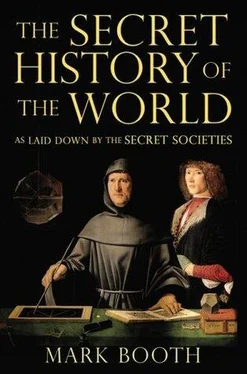The ancient texts describing this era also lay great emphasis on its giants. The author of the Book of Enoch writing in the Hebrew tradition and Plato writing in the Greek tradition agree that in these early pre-Flood times there arose a race of giants. In fact, traditions of an antediluvian race of giants can be found all over the world from the Danavas and Daityas of India to the Miaotse of China. In a Dialogue between Midas the Phrygian and Silenus that has survived in fragmentary form from the time of Alexander the Great, Silenus says that ‘men grew to double the size of the tallest men in his time, and they lived to twice the age’. In the secret tradition, the gigantic Bamyan statues recently destroyed in Afghanistan were not three giant statues of buddhas but three life-sized statues of giants of 173, 120 and 30 feet high. The drapery that made them look like buddhas was made of plaster, said to have been added to the stone later. In the nineteenth century it was recorded that the locals believed them to be statues of the Miaotse, the giants of Chinese tradition. The famous statues of Easter Island are also supposed to record the real heights of historical giants.
Then there were the dead-end freaks — the one-legged men, the bat-men, the insect-men and the men with tails. Manetho, an Egyptian historian of the third century BC, also recorded traditions of the progency of the Watchers, writing ‘they… brought double-winged human beings, also others with four wings and two faces, human beings with one body and two heads, still other human beings had thighs of goats and horns upon their heads; others had the feet of horses behind and men in front; there were also others said to have been man-headed bulls and four-headed dogs, whose tails emerged like fish-tails from their backs… and other monsters, such as all kinds of dragon-like beings.’
This, then, is the era remembered in the great myths and finds echoes in great fantasy literature, such as J.R.R. Tolkien’s The Lord of the Rings or the Narnia books of C.S. Lewis. This fantasy literature represents a welling up into the present of a collective memory of this period when humans lived on the earth with giants, dragons, mermaids, centaurs, unicorns, fauns, satyrs. Legions of dwarves, sylphs, nymphs, dryads and other lesser spiritual beings served the gods and humans rubbed shoulders with them, fought battles with them and sometimes fell in love with them.

IN THE SECRET HISTORY, THE LAST CREATURES to incarnate before humans were the apes. They came about because some human spirits rushed into incarnation too early, before human anatomy had been perfected.
In the secret history, therefore, it is not right to say that humans are descended from apes, rather that apes represent a degeneration of humankind .
Of course none of the fabulous creatures have left any trace in the fossil record. So why have the great men and women of history who were initiates of the secret societies believed in them? Why should any intelligent person even begin to toy with the idea?
6. THE ASSASSINATION OF THE GREEN KING
Isis and Osiris • The Cave of the Skull • The Palladium
IN THE PERIOD DESCRIBED BY THE MYTHS of Olympus, gods walked among humans. But the history of the last god to rule as king of the earth is recorded in its fullest version in Egyptian rather than Greek tradition. The Egyptians unquestioningly believed that their most important god had once walked among them, led them into battle and ruled them wisely and well.
Herodotus described a visit to the shrine where Osiris was said to be buried. ‘Gigantic stone obelisks stand in the courtyard and there is a circular artificial lake next to it. It is on this lake at night that the Egyptians act out the Mysteries, the Black Rite that celebrates the death and resurrection of a being whose name I dare not speak. I know what goes on but… say no more.’
Fortunately we can supplement this teasing account with the history of Osiris as told by Herodotus’s near-contemporary Plutarch, an initiate priest of the Oracle at Delphi. In the following I have used Plutarch’s account as a basis, weaving in additional material from other sources…
We have to start by imagining a world at war, ravaged by roaming monsters and wild animals. Osiris was a great hunter, a ‘Beast Master’ — remembered as Orion the Hunter in Greek mythology and Herne the Hunter in Norse mythology — and a great warrior. He cleared the land of predatory beasts and defeated invading armies.
But this great warrior’s downfall came not in combat with monsters or on the battlefield, but because of the enemy within.
Returning from another military campaign, Osiris was welcomed back by cheering crowds, by the populace who loved him. The reign of Osiris, though constantly under attack from outside the country, would be remembered as a golden age. And it was an age of domestic as well as civil bliss. His name is connected with insemination, ‘ourien’ meaning semen, and what we today call the belt of Orion is a euphemism. In ancient times it was a penis that became erect as the new year progressed. These things should alert us to the fact that there is a strong sexual current in the history that follows.
Osiris accepted an invitation from his brother Seth to a gala dinner to celebrate victory.
Some said Osiris had been sleeping with beautiful dark-skinned Nepthys, wife of Seth and sister of his own wife, Isis. Did this provide Seth with a motive for murder? He may not have needed one. The clue to Seth’s animosity is contained in his name. He was an envoy of Satan.
After dinner Seth announced a game. He had made a beautiful chest, something like a coffin but fashioned out of cedar and inlaid with gold, silver, ivory and lapis lazuli. Whoever fitted most neatly into this chest, he said, could take it away.
One by one the guests tried but they were too fat, to thin, too tall, too short. Finally Osiris stepped in and lay down. ‘It fits!’ he cried. ‘Fits me like the skin I was born in!’
But his pleasure at winning was cut short as Seth slammed down the lid. Seth hammered in nails and filled every crack with molten lead — the metal of Satan. Then Seth and his followers carried the chest down to the banks of the Nile and cast it on the waters.
Osiris was an immortal, and Seth knew he couldn’t kill him, but he could, he believed, get rid of him for good.
The chest floated down the Nile for several days and nights, eventually washing ashore on the coast of what we now call Syria. A tender young tamarisk tree growing there wrapped the chest in its branches, and eventually grew all around it, enclosing it lovingly and protectively in its trunk. In time this tree became famous for its splendour, and the king of Syria had it chopped down and fashioned into a pillar that stood in the centre of his palace.
In the meantime Isis, separated from her man and deposed from her throne, cut her hair, blackened her face with cinders and wandered the surface of the earth, searching, tearfully, for her beloved husband. After a while she took a job as a servant girl at the court of a foreign king. (Readers will readily appreciate how this story, originally a sacred drama in the temples of Egypt, has come down to us in slightly garbled form as the pantomime Cinderella .)
But Isis never gave up hoping to find her man, and one day her magic powers led her to see Osiris clairvoyantly in the chest inside the tree in the middle of the very palace where she was working, the palace of the Syrian king. Isis revealed her true identity as a queen and persuaded the king to chop down the pillar and let her take the chest away.
Читать дальше













